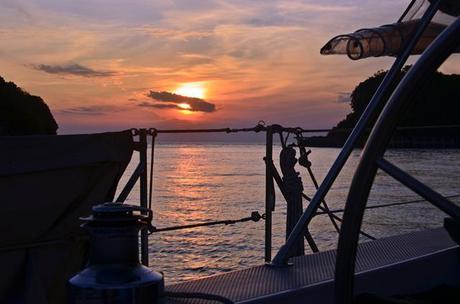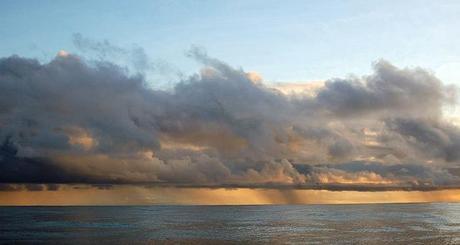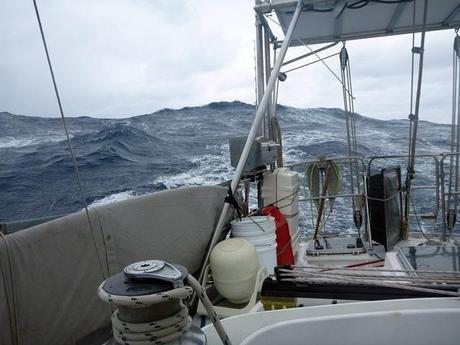
Jamie and I co-author the cruising column for 48° North, a Pacific Northwest regional boating magazine. He lead on this piece for their for October issue, with ruminations about what lies ahead for us with a big year coming. The complete magazine is free on newstands around the Salish Sea, and available online wherever you are.
Transition then Monsoon
Southwest monsoon season is active here in the Malacca Straits. Intense squalls with cold, biting rain, and streaks of lightning that are always too close divide the day’s oppressive heat. It is extreme weather – eerily calm, blindingly bright or catastrophically loud. Local fishermen live the pattern of these conditions, in rickety open boats.
Transitions between monsoon seasons are less predictable. Last year in southern Phuket Thailand a strong southeasterly surprised many sailors, leaving 40 boats firmly planted on the beach. Wind from the southeast, outrageous! What’s next- westerly winds?
It’s easy to fall into patterns that fit the season. Whether calm anchorages with good Thai food just a dinghy ride away or squally nights with a mug of strong coffee, cruising sailors adapt then settle, transition then monsoon. Sailing between regions confuses the pattern. We’re in monsoon season now, but on board Totem it’s all about transition as we gear-up to cross the Indian Ocean.

Ocean crossing preparations feel different this time compared our Pacific transit in 2010. The Pacific Ocean has a familiarity about it; partly from living along its eastern reaches, and partly from reading so many tales of the South Seas. Think of the Pacific and words like tropical, paradise, tranquil, pristine, exotic, and freedom come to mind. Even the island names sound enticing: Fakarava, Huahine, Naviti.
Think of sailing the Indian Ocean and piracy, rough weather and one missing jumbo jet come to mind. Many blue water sailors that press on to reach the western Pacific don’t continue beyond. The Pacific may have many more islands and a very peaceful sounding name, but it’s also more than double the Indian’s size and it’s not always so serene. Perhaps if early traders and explorers dubbed it Harmony Ocean, instead of referencing the Indian subcontinent, this stretch of water between Australia and Asia it wouldn’t intimidate sailors as much.

Reputation has a funny way of fooling us into believing without really knowing; but hearsay isn’t personal. If we’ve only learned one grain of wisdom while traveling it’s that you need to experience a place for yourself to begin to know it. Our favorite anchorage may be another cruisers worst place ever. Papua New Guinea has a terrible reputation as a sailing destination due to violent crime. After much hard research and trepidation, we sailed a safe path through beauty and ancient lifestyles to have an experience that was great beyond words.
The Indian Ocean does have its tragedies – Somali pirates around the horn of Africa and mountainous seas. The Red Sea route is clearly not a safe option so we’ll avoid the region. Consequently, the region of mountainous seas is not avoidable, but dramatic sea conditions are generally seasonal or predictable. So instead of focusing on Indian Ocean maladies, we’re looking forward to the Maldives – along with a small but growing number of cruisers rediscovering a host beautiful places.
Eliminating Somalia and the Red Sea, there are two routes to South Africa. The southern route begins in Indonesia’s Sunda Strait, in sight of Anak Krakatau (child of Krakatoa) born from the massive eruption of in 1883. From there it’s a relatively short 600 mile trip to Cocos-Keeling, visited by Joshua Slocum in 1897. The next leg is the longest at 2,300 miles to the islands east of Madagascar: Rodrigues, Mauritius, and Reunion. Each island has unique biodiversity, and cultural influences from African, Arab, Asian, and European traders and explorers.
Totem will take the northern route, which offers more stops along the way. From western Malaysia, the first is either India’s Andaman Islands, just 400 miles away, or Sri Lanka at about 1,100 miles. The Andamans look beautiful, but we’re put off by restrictive visa requirements and reports of better marine life elsewhere. In Sri Lanka, we hope to be one of the few yachts to visit the northeast port of Trincomalee since the end of the 25 year long civil war. Then westward 700 miles to the smallest country in Asia, Republic of Maldives, whose highest point of land is just eight feet above sea level. South 600 miles are the coral islands of Chagos, home to the largest marine reserve in the world. Underwater life is simply spectacular, or so goes the reputation –we’ll see! From there, we would love to visit the Seychelles, if piracy remains we’ll clear of the area; then south to Mayotte, Comoros, and Madagascar.

Visa requirements, adding pages to our well-stamped passports, endless boat maintenance, crew maintenance, and safety drills outline a simplified version of tasks during this transition from coastal to ocean sailing. We recently hired diesel mechanics for a 5,000 engine service – preventative maintenance. As we suspected, water pumps, start motor, and heat exchanger were in need of professional help. Unfortunately, there was very minor mistake made that led to a series of overheating events. Preventative maintenance became repairs required, due to a blown head gasket. Frustrating yes, and also educational and fun working with two upbeat Malaysian speaking mechanics that answered every one of my questions with “ok, ok, ok” (said very quickly).
Preparation is tiring in the tropics. As the sky blooms with the setting sun, challenges of the day fade. We look west to the places we’ll soon visit, and wonder. Will we swim with as many sharks in Chagos as in the Cook Islands? Will Madagascar have a bartering culture like Papua New Guinea? Have the French-subsidized baguettes and brie pad our waistlines in Mayotte as they did in French Polynesia? A few friends that are now crossing the Indian Ocean now are reporting better coral and more fish than they saw in the Pacific. In the last few months we’ve shared sunsets with veteran Indian Ocean sailors, South Africans mostly, waxing on with nostalgia of the beautiful anchorages and people along the way. It feeds our dreams, while reminding us of crossing the Pacific: tropical, paradise, tranquil, pristine, exotic, and free.
The engine is fixed. The rat problem is no more. The life raft is certified. And we can’t wait for the next monsoon season!
Well seasoned followers know we love it when you read this on the Sailfeed website.

